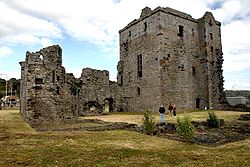
Rosyth Castle
Encyclopedia

Tower house
A tower house is a particular type of stone structure, built for defensive purposes as well as habitation.-History:Tower houses began to appear in the Middle Ages, especially in mountain or limited access areas, in order to command and defend strategic points with reduced forces...
on the perimeter of Rosyth Naval Dockyard, Fife
Fife
Fife is a council area and former county of Scotland. It is situated between the Firth of Tay and the Firth of Forth, with inland boundaries to Perth and Kinross and Clackmannanshire...
, Scotland
Scotland
Scotland is a country that is part of the United Kingdom. Occupying the northern third of the island of Great Britain, it shares a border with England to the south and is bounded by the North Sea to the east, the Atlantic Ocean to the north and west, and the North Channel and Irish Sea to the...
.
It originally stood on a small island in the Firth of Forth
Firth of Forth
The Firth of Forth is the estuary or firth of Scotland's River Forth, where it flows into the North Sea, between Fife to the north, and West Lothian, the City of Edinburgh and East Lothian to the south...
accessible only at low tide, and dates from around 1450, built as a secure residence by Sir David Stewart, who had been granted the Barony of Rosyth
Rosyth
Rosyth is a town located on the Firth of Forth, three miles south of the centre of Dunfermline. According to an estimate taken in 2008, the town has a population of 12,790....
in 1428.
The original tower house (58 feet high) was enlarged and extended in the 16th and early 17th centuries.
In 1572 it was attacked from Blackness Castle
Blackness Castle
Blackness Castle is a 15th century fortress, near the village of Blackness, Scotland, on the south shore of the Firth of Forth. It was built, probably on the site of an earlier fort, by Sir George Crichton in the 1440s. At this time, Blackness was the main port serving the Royal Burgh of...
on the southern shore of the Firth of Forth
Firth of Forth
The Firth of Forth is the estuary or firth of Scotland's River Forth, where it flows into the North Sea, between Fife to the north, and West Lothian, the City of Edinburgh and East Lothian to the south...
and it was occupied in 1651 by Oliver Cromwell
Oliver Cromwell
Oliver Cromwell was an English military and political leader who overthrew the English monarchy and temporarily turned England into a republican Commonwealth, and served as Lord Protector of England, Scotland, and Ireland....
's army after the Battle of Inverkeithing
Battle of Inverkeithing
The Battle of Inverkeithing was a battle of the Wars of the Three Kingdoms. It was fought on 20 July 1651 between an English Parliamentarian army under John Lambert and a Scottish Covenanter army acting on behalf of Charles II, led by Sir John Brown of Fordell. Lambert's force was a seaborne...
.
It remained a Stewart residence until it was sold in the late seventeenth century to David Drummond of Invermay
Invermay
Invermay is a diffuse settlement in Perth and Kinross, Scotland. It is situated approximately 2 km southeast of Forteviot on the Water of May, some 8 km southwest of Perth.An early medieval freestanding cross was once located at Invermay...
. It ultimately ended up in the possession of the Earl of Hopetoun and from the eighteenth century onward remained unoccupied. During this and later periods large parts of the stonework were re-used in other structures, and the later courtyard buildings were almost razed to the ground, leaving only the tower and north courtyard wall remaining significantly above ground floor level.
It became Admiralty
Admiralty
The Admiralty was formerly the authority in the Kingdom of England, and later in the United Kingdom, responsible for the command of the Royal Navy...
property in 1903 and as the result of land reclamation lost its waterfront position, becoming marooned within the dockyard. Although plans were made to restore and use the building they came to nothing and the structure was made safe in its current condition. It passed into private hands when large tracts of the surrounding dockyard were sold.
About half a mile north of the castle is a well preserved sixteenth century dovecot
Dovecot
Dovecot may refer to:* Dovecot, Merseyside, an area of the City of Liverpool* Dovecot , an IMAP and POP software package-See also:* Dovecote, a building for pigeons or doves* Dovecote...
, with a crow-stepped gable roof, with carved heads at two corners. Internally it has a barrel vault
Barrel vault
A barrel vault, also known as a tunnel vault or a wagon vault, is an architectural element formed by the extrusion of a single curve along a given distance. The curves are typically circular in shape, lending a semi-cylindrical appearance to the total design...
ed ceiling.

